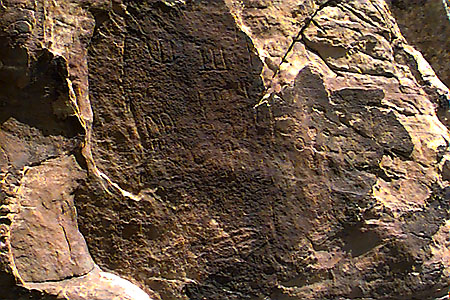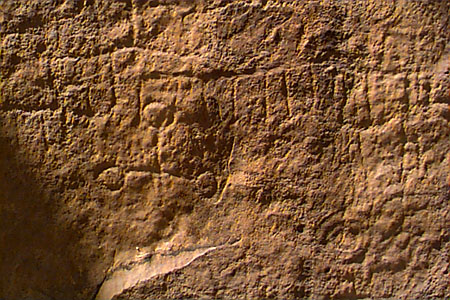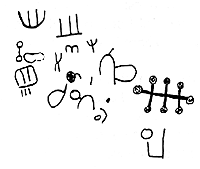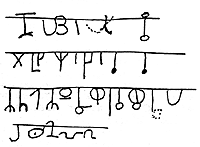
|
The Mystery of Ancient America's
ViewZone will attempt to give you all the details. We have been given a rough map that has many unmarked roads that can be found only by looking for landmarks. Much of the land is devoted to cattle and we have frequent encounters with animals that are either lying down in the road or are startled by our vehicle and run in front of us. The map could be that of a small village but, in reality, it covers about 200 miles. We were instructed to stop at certain locations and "hunt" for the petroglyphs. Notations made by Bill, like "look on top of cliff," was our only clue.  Our first stop required that we climb down into a large flat canyon which is bordered by two parallel stone walls. The climb is difficult but the reward is well worth the effort. At the bottom we can see a large collections of symbols, arranged in a row. These symbols are pecked deep into the rock face and have some residual chalk from prior attempts to make them photograph better. This "enhancement" is unfortunate because it precludes any valid means to determine the age by contaminating the patina. This particular collection of symbols was perhaps the best example of what has been called "writing" and what, according to Bill McGlone, could very well be in the ancient alphabet called Thamudic.  Bill informed us that the famous writer, Barry Fell, examined these same petroglyphs in photographs and was the first to suggest that they were ancient writing. Unfortunately for Fell, the photographs were not detailed enough to discriminate between the petroglyphs and naturally formed rock stains. When Fell's attempt at a translation was reviewed at this site, this was abundantly clear - even to Fell. Although Fell was on the right track, his work was summarily discredited and the possibility of these symbols being "writing" was largely ignored by scholars. 
Chalk is not used any more for enhancing these marks. Bill McGlone and his team once had success with aluminum powder which they painstakingly applied to the grooves and photographed. The aluminum was inert and could easily be washed from the petroglyphs after the photographs were taken. It should not have hindered any age determination techniques, however, the current opinion is to leave the walls untouched. Our digitally enhanced images are the best for recording these ancient messages. Some of the illustrations shown here were made with this aluminum enhancement and we are grateful to Bill for sharing these old photographs with us.
 The symbols appear to have been carved at different times, perhaps to mark the passing of time as with a calendar or to help with the telling of a long story. The truth is we do not know. We only know that a Thamudic alphabet can be seen in these "musical notes" and appear to be purposely and meticulously etched with great effort and over a long period of time. 
|


